2017 Hyundai Elantra manual transmission
[x] Cancel search: manual transmissionPage 400 of 571

5-24
Driving your vehicle
Manual shift mode
Whether the vehicle is stationary or
in motion, manual shift mode is
selected by pushing the shift lever
from the D (Drive) position into the
manual gate. To return to D (Drive)
range operation, push the shift lever
back into the main gate.
In manual shift mode, moving the
shift lever rearwards and forwards
will allow you to select the desired
range of gears for the current driving
conditions.
+ (Up) : Push the lever forward once
to shift up one gear.
- (Down) : Pull the lever rearwards
once to shift down one
gear.
Information
• Only the six forward gears can be
selected. To reverse or park the
vehicle, move the shift lever to the R
(Reverse) or P (Park) position as
required.
• Downshifts are made automatically
when the vehicle slows down. When
the vehicle stops, 1stgear is automat-
ically selected.
• When the engine rpm approaches
the red zone the transmission will
upshift automatically.
(Continued)
(Continued)
• If the driver presses the lever to
+ (Up) or - (Down) position, the
transmission may not make the
requested gear change if the next
gear is outside of the allowable
engine rpm range. The driver must
execute upshifts in accordance with
road conditions, taking care to keep
the engine rpms below the red zone.
• When driving on a slippery road,
push the shift lever forward into the
+ (Up) position. This causes the
transmission to shift into the 2nd
gear which is better for smooth driv-
ing on a slippery road. Push the shift
lever to the - (Down) side to shift
back to the 1stgear.
• When driving in manual shift mode,
slow down before shifting to a lower
gear. Otherwise, the lower gear may
not be engaged if the engine rpms
are outside of the allowable range.
iOAD055006R
+ (UP)
- (DOWN)
Page 407 of 571
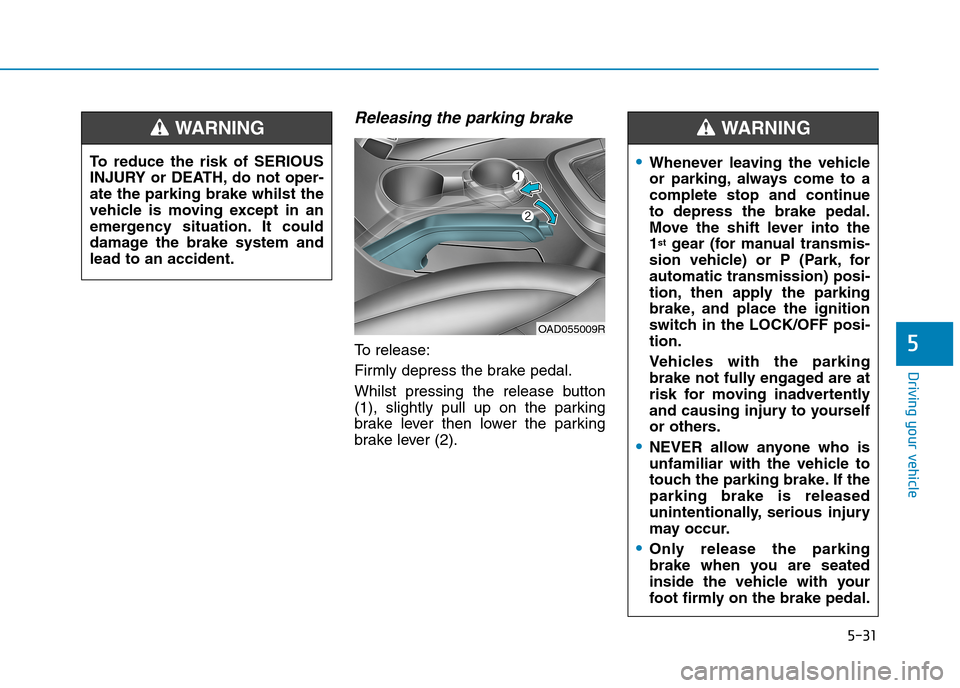
5-31
Driving your vehicle
5
Releasing the parking brake
To r e l e a s e :
Firmly depress the brake pedal.
Whilst pressing the release button
(1), slightly pull up on the parking
brake lever then lower the parking
brake lever (2).
OAD055009R
To r e d u c e t h e r i s k o f S E R I O U S
INJURY or DEATH, do not oper-
ate the parking brake whilst the
vehicle is moving except in an
emergency situation. It could
damage the brake system and
lead to an accident.
WA R N I N G
•Whenever leaving the vehicle
or parking, always come to a
complete stop and continue
to depress the brake pedal.
Move the shift lever into the
1stgear (for manual transmis-
sion vehicle) or P (Park, for
automatic transmission) posi-
tion, then apply the parking
brake, and place the ignition
switch in the LOCK/OFF posi-
tion.
Vehicles with the parking
brake not fully engaged are at
risk for moving inadvertently
and causing injury to yourself
or others.
•NEVER allow anyone who is
unfamiliar with the vehicle to
touch the parking brake. If the
parking brake is released
unintentionally, serious injury
may occur.
•Only release the parking
brake when you are seated
inside the vehicle with your
foot firmly on the brake pedal.
WA R N I N G
Page 419 of 571
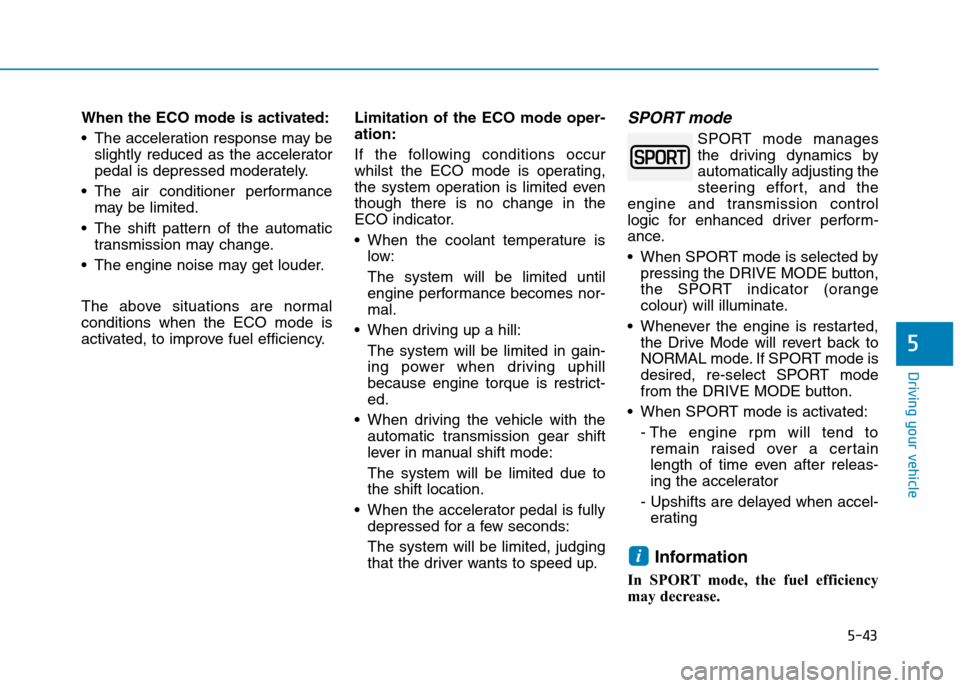
5-43
Driving your vehicle
5
When the ECO mode is activated:
•The acceleration response may be
slightly reduced as the accelerator
pedal is depressed moderately.
•The air conditioner performance
may be limited.
•The shift pattern of the automatic
transmission may change.
•The engine noise may get louder.
The above situations are normal
conditions when the ECO mode is
activated, to improve fuel efficiency.
Limitation of the ECO mode oper-
ation:
If the following conditions occur
whilst the ECO mode is operating,
the system operation is limited even
though there is no change in the
ECO indicator.
•When the coolant temperature is
low:
The system will be limited until
engine performance becomes nor-
mal.
•When driving up a hill:
The system will be limited in gain-
ing power when driving uphill
because engine torque is restrict-
ed.
•When driving the vehicle with the
automatic transmission gear shift
lever in manual shift mode:
The system will be limited due to
the shift location.
•When the accelerator pedal is fully
depressed for a few seconds:
The system will be limited, judging
that the driver wants to speed up.
SPORT mode
SPORT mode manages
the driving dynamics by
automatically adjusting the
steering effort, and the
engine and transmission control
logic for enhanced driver perform-
ance.
•When SPORT mode is selected by
pressing the DRIVE MODE button,
the SPORT indicator (orange
colour) will illuminate.
•Whenever the engine is restarted,
the Drive Mode will revert back to
NORMAL mode. If SPORT mode is
desired, re-select SPORT mode
from the DRIVE MODE button.
•When SPORT mode is activated:
- The engine r pm will tend to
remain raised over a certain
length of time even after releas-
ing the accelerator
- Upshifts are delayed when accel-
erating
Information
In SPORT mode, the fuel efficiency
may decrease.
i
Page 429 of 571
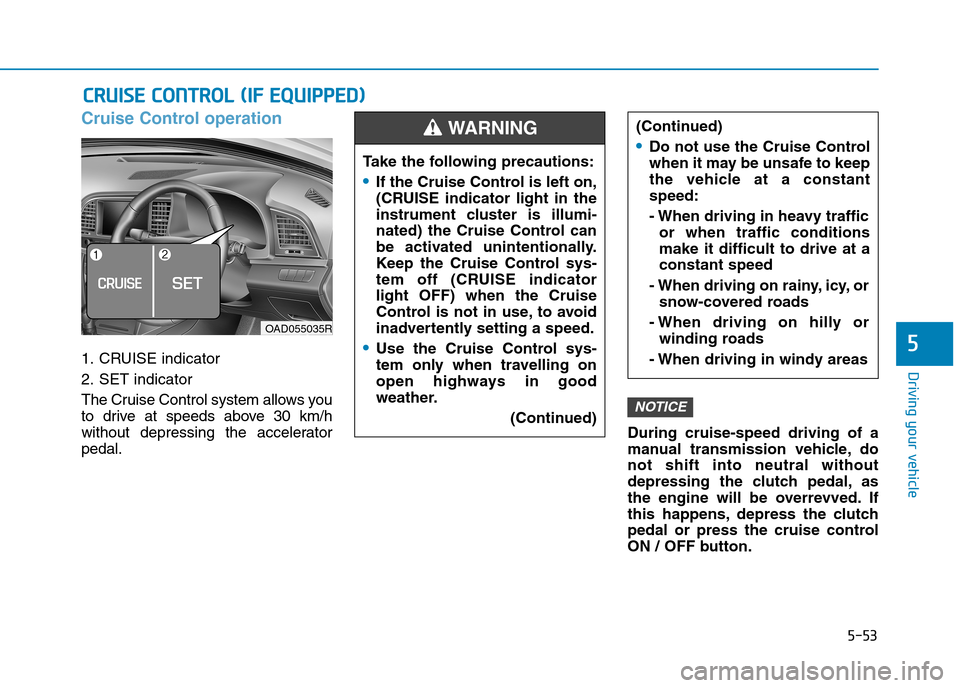
5-53
Driving your vehicle
5
Cruise Control operation
1. CRUISE indicator
2. SET indicator
The Cruise Control system allows you
to drive at speeds above 30 km/h
without depressing the accelerator
pedal.
During cruise-speed driving of a
manual transmission vehicle, do
not shift into neutral without
depressing the clutch pedal, as
the engine will be overrevved. If
this happens, depress the clutch
pedal or press the cruise control
ON / OFF button.
NOTICE
CCRRUUIISSEE CCOONNTTRROOLL ((IIFF EEQQUUIIPPPPEEDD))
Ta k e t h e f o l l o w i n g p r e c a u t i o n s :
•If the Cruise Control is left on,
(CRUISE indicator light in the
instrument cluster is illumi-
nated) the Cruise Control can
be activated unintentionally.
Keep the Cruise Control sys-
tem off (CRUISE indicator
light OFF) when the Cruise
Control is not in use, to avoid
inadvertently setting a speed.
•Use the Cruise Control sys-
tem only when travelling on
open highways in good
weather.
(Continued)
(Continued)
•Do not use the Cruise Control
when it may be unsafe to keep
the vehicle at a constant
speed:
- When driving in heavy traffic
or when traffic conditions
make it difficult to drive at a
constant speed
- When driving on rainy, icy, or
snow-covered roads
- When driving on hilly or
winding roads
- When driving in windy areas
WA R N I N G
OAD055035R
Page 430 of 571
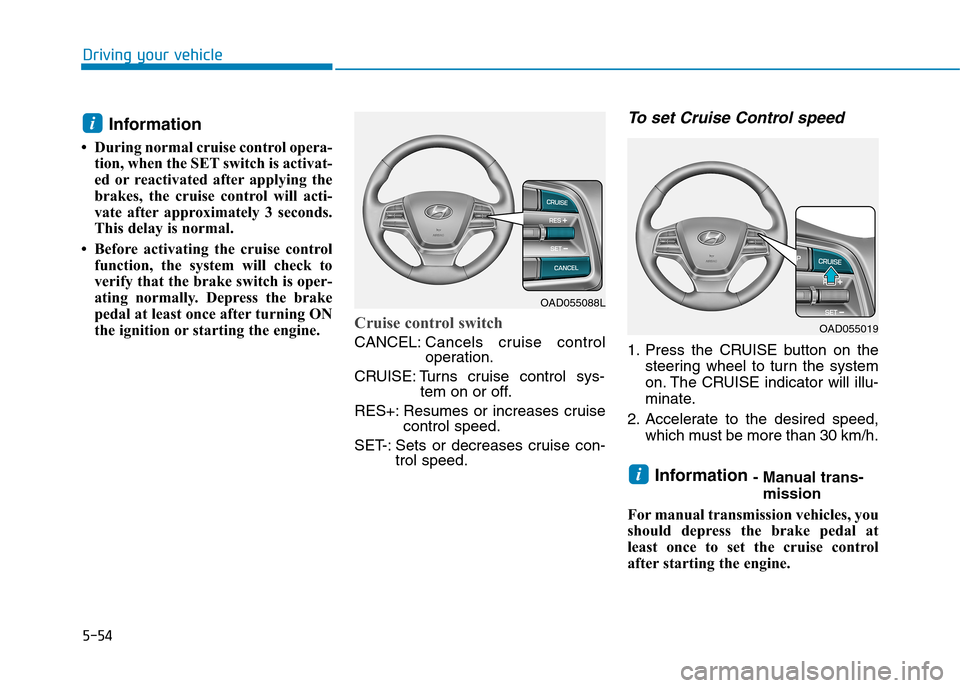
5-54
Driving your vehicle
Information
• During normal cruise control opera-
tion, when the SET switch is activat-
ed or reactivated after applying the
brakes, the cruise control will acti-
vate after approximately 3 seconds.
This delay is normal.
• Before activating the cruise control
function, the system will check to
verify that the brake switch is oper-
ating normally. Depress the brake
pedal at least once after turning ON
the ignition or starting the engine.Cruise control switch
CANCEL:Cancels cruise controloperation.
CRUISE: Turns cruise control sys-tem on or off.
RES+: Resumes or increases cruisecontrol speed.
SET-: Sets or decreases cruise con-trol speed.
To s e t C r u i s e C o n t r o l s p e e d
1. Press the CRUISE button on the
steering wheel to turn the system
on. The CRUISE indicator will illu-
minate.
2. Accelerate to the desired speed,
which must be more than 30 km/h.
Information - Manual trans-
mission
For manual transmission vehicles, you
should depress the brake pedal at
least once to set the cruise control
after starting the engine.
i
i
OAD055088L
OAD055019
Page 432 of 571
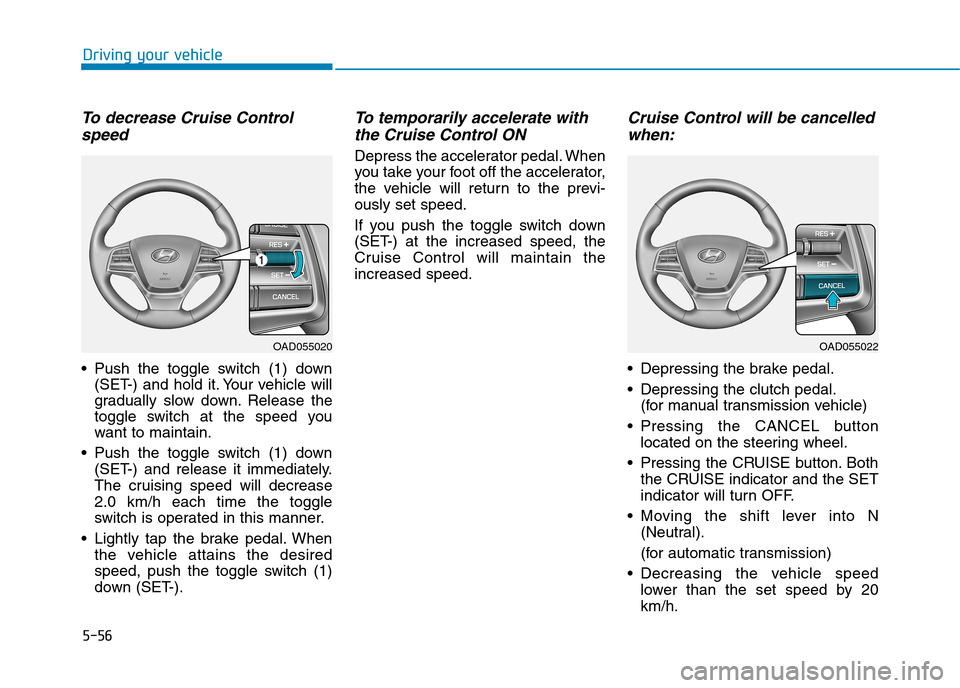
5-56
Driving your vehicle
To d e c r e a s e C r u i s e C o n t r o l
speed
•Push the toggle switch (1) down
(SET-) and hold it. Your vehicle will
gradually slow down. Release the
toggle switch at the speed you
want to maintain.
•Push the toggle switch (1) down
(SET-) and release it immediately.
The cruising speed will decrease
2.0 km/h each time the toggle
switch is operated in this manner.
•Lightly tap the brake pedal.When
the vehicle attains the desired
speed, push the toggle switch (1)
down (SET-).
To t e m p o r a r i l y a c c e l e r a t e w i t h
the Cruise Control ON
Depress the accelerator pedal. When
you take your foot off the accelerator,
the vehicle will return to the previ-
ously set speed.
If you push the toggle switch down
(SET-) at the increased speed, the
Cruise Control will maintain the
increased speed.
Cruise Control will be cancelled
when:
•Depressing the brake pedal.
•Depressing the clutch pedal.
(for manual transmission vehicle)
•Pressing the CANCEL button
located on the steering wheel.
•Pressing the CRUISE button.Both
the CRUISE indicator and the SET
indicator will turn OFF.
•Moving the shift lever into N
(Neutral).
(for automatic transmission)
•Decreasing the vehicle speed
lower than the set speed by 20
km/h.
OAD055020OAD055022
Page 447 of 571
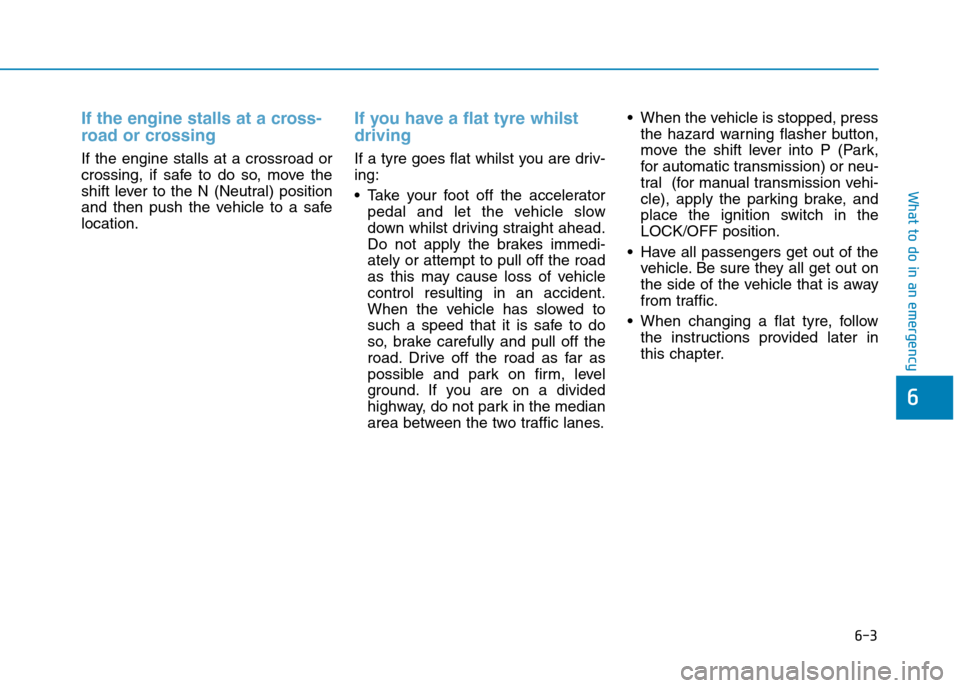
6-3
What to do in an emergency
If the engine stalls at a cross-
road or crossing
If the engine stalls at a crossroad or
crossing, if safe to do so, move the
shift lever to the N (Neutral) position
and then push the vehicle to a safe
location.
If you have a flat tyre whilst
driving
If a tyre goes flat whilst you are driv-
ing:
•Take your foot off the accelerator
pedal and let the vehicle slow
down whilst driving straight ahead.
Do not apply the brakes immedi-
ately or attempt to pull off the road
as this may cause loss of vehicle
control resulting in an accident.
When the vehicle has slowed to
such a speed that it is safe to do
so, brake carefully and pull off the
road. Drive off the road as far as
possible and park on firm, level
ground. If you are on a divided
highway, do not park in the median
area between the two traffic lanes.
•When the vehicle is stopped, press
the hazard warning flasher button,
move the shift lever into P (Park,
for automatic transmission) or neu-
tral (for manual transmission vehi-
cle), apply the parking brake, and
place the ignition switch in the
LOCK/OFF position.
•Have all passengers get out of the
vehicle. Be sure they all get out on
the side of the vehicle that is away
from traffic.
•When changing a flat tyre, follow
the instructions provided later in
this chapter.
6
Page 450 of 571
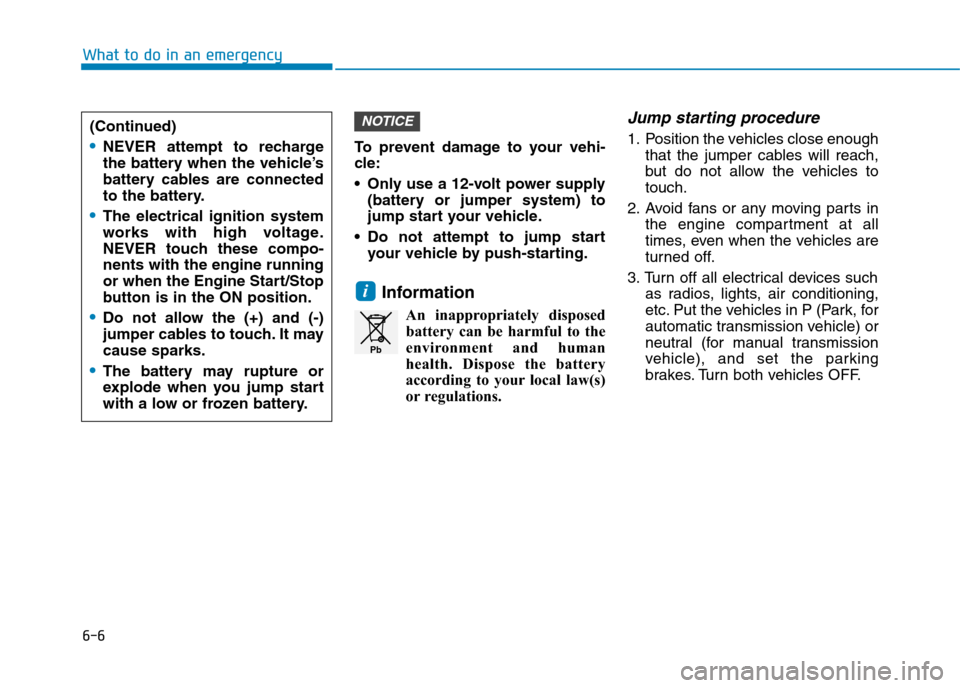
6-6
What to do in an emergency
To p r e v e n t d a m a g e t o y o u r v e h i -
cle:
•Only use a 12-volt power supply
(battery or jumper system) to
jump start your vehicle.
•Do not attempt to jump start
your vehicle by push-starting.
Information
An inappropriately disposed
battery can be harmful to the
environment and human
health. Dispose the battery
according to your local law(s)
or regulations.
Jump starting procedure
1. Position the vehicles close enough
that the jumper cables will reach,
but do not allow the vehicles to
touch.
2. Avoid fans or any moving parts in
the engine compartment at all
times, even when the vehicles are
turned off.
3. Turn off all electrical devices such
as radios, lights, air conditioning,
etc. Put the vehicles in P (Park, for
automatic transmission vehicle) or
neutral (for manual transmission
vehicle), and set the parking
brakes. Turn both vehicles OFF.
i
NOTICE
Pb
(Continued)
•NEVER attempt to recharge
the battery when the vehicle’s
battery cables are connected
to the battery.
•The electrical ignition system
works with high voltage.
NEVER touch these compo-
nents with the engine running
or when the Engine Start/Stop
button is in the ON position.
•Do not allow the (+) and (-)
jumper cables to touch. It may
cause sparks.
•The battery may rupture or
explode when you jump start
with a low or frozen battery.